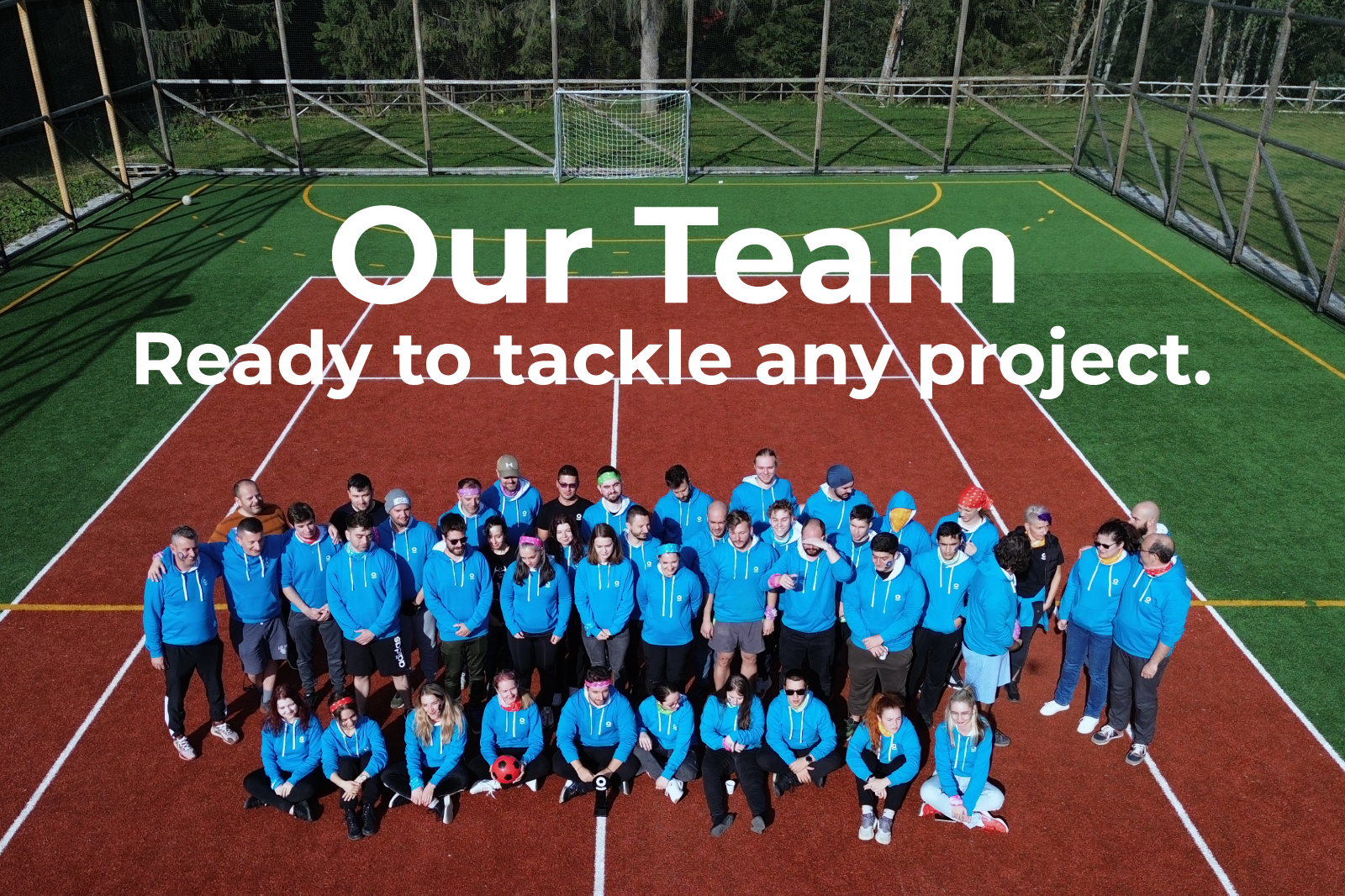
How to hire healthcare software developers
Hiring healthcare software developers is challenging, even for experienced companies with an established track record of outsourcing their projects. Why? Healthcare software development companies are scarce, considering the particularities of the field, regulatory practices, and the focus on security. Worry not; this article will explore the main aspects you should consider to make your life (and job) easier.
Firstly, let’s explore if you would be better off creating your in-house team or outsourcing it.
In-house vs. Outsourcing healthcare custom software developers
Let’s dive into the main differences, benefits, and downsides of creating or outsourcing an in-house team.
Costs—The in-house option is usually more expensive due to additional expenses such as office space, employee benefits, health insurance, taxes, etc. When you outsource medical software developers, your provider is responsible for those costs, meaning outsourcing is more cost-efficient.
Talent pool—Be honest. How many healthcare software developers do you know? When building your in-house team, consider the talent pool size in the area. Outsourcing is a better option as it can harness talent from across the globe for your project.
Communication and Collaboration: This is a significant point and often overlooked. Your in-house team will communicate clearly and directly, especially with the right team leaders/management. Outsourcing healthcare software developers can be challenging due to language and/or cultural differences. Time zone differences also have to be a consideration.
*At Ontegra, all our healthcare software engineers, developers, and UI/UX designers are excellent English speakers with extensive experience in the field and working with worldwide companies and international teams.
Intellectual Property—In-house development gives you complete control over the healthcare software development project IP. If you decide to outsource, just make sure to agree on IP ownership and confidentiality.
Project Management—This one is a bit more difficult to assess. If you have outstanding management practices and experience creating and deploying custom healthcare software projects, you can be confident that in-house is an excellent option. If you want to focus on your core business activity and/or don’t have experience in this type of management, you would be better off letting a specialized company handle it from start to finish.
Our team has extensive experience taking the ropes of complex, custom healthcare software development projects from discovery and research to development, launch, maintenance, and training.
For a more comprehensive look at and comparison between in-house and outsourcing software development, check out our in-depth article here.
If you decide to go in-house after considering all the above points, your next step should be to focus on the recruitment plan. If you’d like to consider outsourcing, keep reading as we will explore the essential things to consider so you can have peace of mind that you selected the best possible partner for your project.
Onshore vs. Offshore vs. Nearshore
We'll keep things simple if you’re not acquainted with these terms. Onshore is when you outsource to a company from the same region or country. Offshore is when you outsource to a distant country, and Nearshore is when you outsource to a neighboring/in proximity country.
Onshore healthcare software development outsourcing
Benefits - Better time zone alignment, language, and cultural similarity can improve communication. Good regulatory compliance is essential as they function in the same economic environment as you. You also get better quality control by frequently visiting them and assessing their progress and performance.
Downsides—Resources might be scarce in your region/country. As previously noted, hiring healthcare software developers can be difficult due to the limited talent pool. For most businesses, this might be the most costly outsourcing option.
Offshore healthcare software development outsourcing
Benefits—Outsourcing to distant markets is usually best for cost savings, as fee differences are pretty high between regions globally. Also, based on your technical requirements, you might have better access to the right talent pool, which means you can scale projects much more quickly.
Downsides—If time zone differences are too high, they might become an issue, and you need to consider the cultural and linguistic barriers that might arise. Quality control and compliance should be a focus, as you must ensure the partner of your choice has high standards in quality assurance and well-set compliance procedures.
At Ontegra, being a Romanian healthcare software development company naturally implies excellent English proficiency from all our teams, close cultural similarities with Western and US markets, and high standards in quality assurance and compliance procedures aligned with Western Europe, the US, and Canada.
Nearshore healthcare software development outsourcing
Benefits—Outsourcing to a neighboring country means you have reasonable proximity, similar time zones, and similar cultures. In many cases, this might be a more cost-efficient option than Offshore outsourcing, but it is not as good as Offshore.
Downsides—Costs—Yes, we did say Nearshore is more cost-efficient, but if this is on your top priority list, Offshore might be a better option. Of course, this is dependent on your base of operations. For example, if your company is based in Western Europe, nearshoring to Eastern Europe might be the best option, as you can balance cost efficiency with quality.
Another notable downside could be the available talent pool, depending on your geographical presence.
Costs of Healthcare Software Developers around the Globe
We researched multiple sources and compiled a list of hourly fee averages worldwide to understand better the potential implied costs and what you might get for your money.
Northern America (USA, Canada) - Average hourly rates are between $70 - $150. What to consider: the high rates are usually justified by quality, regulatory compliance, and similar language and culture if your company is in the US, Canada, or Western Europe.
Latin America (Brazil, Argentina)—Average hourly rates are between $20 and $65. What to consider: the rates are competitive and usually offer good communication and time zone proximity to the US.
Asia (India, China, Philippines, Vietnam)—Average hourly rates are between $15 and $60. What to consider: This is usually a good option for projects focusing on cost savings. They also provide an extended talent pool, but you must consider the significant time zone differences and varied quality standards.
Eastern Europe (Romania, Poland, Ukraine)—Average hourly rates are between $25 and $70. What to consider: Costs are moderate, and you get an outstanding balance between fees and high-quality software products. Healthcare software developers in Eastern Europe are usually highly educated, and the cultural and linguistic differences are not a problem compared to Western Europe and the US.
Western Europe (UK, Germany, France, Netherlands)—Average hourly rates are between $60 and $150. What to consider: high costs usually translate into good regulatory compliance and high-quality products. Good cultural alignment with the US & Canada.
Middle East (Israel, UAE)—Average hourly rates are between $40 and $100. What to consider: rates are competitive, they have a growing tech pool, and they have good cybersecurity knowledge.
Africa (Nigeria, Kenya, South Africa)—Average hourly rates are between $20 and $50. What to consider: Africa is an emerging tech talent pool with cost-effective rates and relatively good English-speaking professionals.
The required skills & expertise for healthcare software developers
Below, we summarize the primary skills and expertise required of successful healthcare software developers and include the roles you should find in an experienced healthcare software development team. These will significantly help you decide on the best project partner.
Programming Language and Frameworks:
Most used languages: Java, #C, Python, JavaScript;
Frameworks: .NET, Spring, Django, React.js;
Database management: SQL, NoSQL databases: PostgreSQL, MySQL, MongoDB, Cassandra;
Cloud computing: AWS, Azure, Google Cloud;
Security Protocols: SSL/TLS, OAuth, SAML for secure data transmission;
Interoperability standards: HL7, FHIR, and DICOM for healthcare data standards and integration with other systems;
DevOps and CI/CD: Jenkins, Docker, and Kubernetes for integration, deployment, and operational efficiency.
Required experience for healthcare software developers
Good knowledge in compliance practices: HIPPA, GDPR, FDA Guidelines;
Extensive industry know-how: experience in developing software solutions for the healthcare industry, patient management systems, electronic health records, and more;
Project Management: good expertise in Agile and Scrum methodologies;
UI/UX: experience in designing user-friendly interfaces that both patients and professionals can use;
Data analytics: experience in data analytics, machine learning, and AI to process and extract valuable insights.
The roles you should consider for the outsourcing healthcare software developers team:
Project Manager
Product Owner
Business Analyst
Software Architects
Developers (frontend and backend)
QA Engineers
UI/UX Designers
Data scientists/analysts
DevOps Engineers
Compliance & Security specialists
With so much information at your disposal and so many things to consider, choosing the right outsourcing healthcare software development company for your project is anything but easy. For the last part, we wanted to add a simplified decision framework to help you decide.
Decision framework for hiring healthcare software developers on a remote basis:
- Assess your company's strategic goals and competencies;
- Evaluate project complexity, size, and duration;
- Analyze your cost-benefits based on the project complexity and the hourly fees of the outsourcing company;
- Analyze your potential provider's track record and portfolio;
- Consider your need for flexibility and scalability. Based on this, you might choose between offshore, onshore, or nearshore;
- Assess your comfort level of direct control over the project. Also, consider your security needs;
- Try to outline an effective plan of communication based on your short-list;
- Evaluate your budget constraints;
- Evaluate your talent pool technical requirements and discuss them with your short-listed companies;
- Define your strategic goals not just for this project but in the long run. Do you want a long-term partnership, or is it a one-time project;
- Check how your short-listed partners ensure quality control and what safeguards are in place to deliver the best possible outcome.
Conclusion - Healthcare Software Developers - How can you hire them efficiently?
There are so many variables, facets, and contextual elements to consider when outsourcing your healthcare software development projects; it’s no wonder it’s such a complex process. With the information we covered in this article, we believe you have the right starting tools to discover the best partner for your project. From deciding over nearshoring, offshoring, and onshoring to their geographic location, technical skillset, cultural and linguistic differences, or similarities, they all play an essential part in your overall project success.

At Ontegra, we offer competitive rates and high-quality deliverables backed up by our proven track record of custom healthcare software development projects. Our main headquarters is in Cluj-Napoca, Romania, which features an extensive pool of highly skilled and educated professionals, good time zone differences, and a very similar cultural mindset to the US and Western Europe. Send us a message to talk about your next healthcare software development project.
Article written by Iulia Filimon, NLP Engineer
Iulia designs and develops algorithms and models that enable computers to understand, interpret, and generate human language. She participates in building the first innovative AI company's solutions and exposing them to clients.